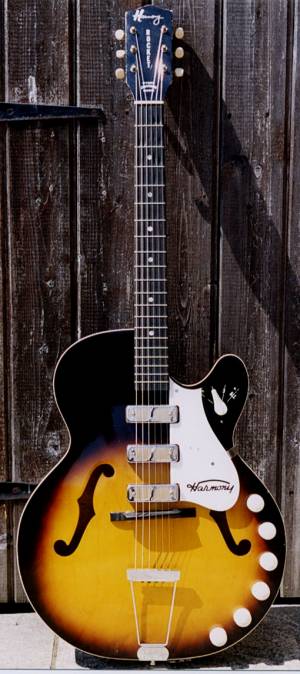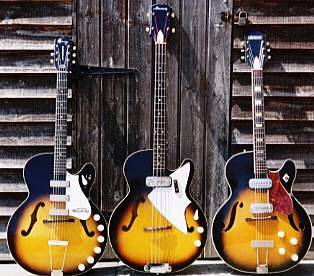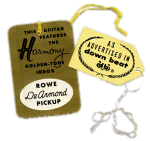
Harmony's famous Rocket line of hollow arch-top electrics was introduced in the late fifties, to offer a budget-priced alternative to Gretsch's Chet Atkins
models and Gibson's ES-125 T, 225T and 350T guitars, basically rockabilly twang-boxes with jazz pretensions.
The Rocket was of all-maple construction, supplied with either 1 pickup (H53), 2 (H54) or 3 pickups (H59),
with a Bigsby tremolo system as an option, though these were replaced in the 1960's by Harmony's own dodgy variant.
At $140, the H59 was the top of the range, featuring 3 DeArmond Golden Tone Indox pickups and a chunky selector switch linked to six controls,
which provided independent volume and tone for each pickup or any combination of all three.
Only Gibson's high-flying (but scarce) ES-5 Switchmaster offered such versatility.
As Harmony's market consisted mainly of beginners and students, corners were cut in the standard of construction and finish. The 24¼"-scale neck was attached to the body with three bolts, and was "steel reinforced" with a non-adjustable truss-rod. The frets were hard-wearing but not particularly well finished, and the non-bound fingerboard featured simple pearl-dot inlays. The Rocket's Achilles' Heel, however, was a tinny trapeze-style tail-piece that did nothing to help the performance of the guitar - a problem Harmony sought to remedy with the inclusion of a T-shaped anchor made of German silver for the Meteor range (see Miss October 2002), which added power and sustain. But these were negligible shortcomings, bearing in mind the closest Gibson equivalent was nearly double the price of a Rocket.
So let's consider the cool stuff. Three twang-tastic DeArmonds, mounted on carved rosewood plinths, with nary a rattle or ground hum to be heard, produce that famous vintage tone that's instantly recognisable to those of us, of a certain age, who fondly remember the pre-Hendrix beat group era.

The leads from the pickups to the switch run across the top of the guitar and are concealed by the pick-guard. The back of the guitar features a lovely piece of flame maple veneer, though its trademark yellow-to-black sunburst finish could have used a few more coats of clear lacquer - it's a tad orange-peely. A sign of the times is evident in the lack of a strap toggle on the upper bout; in those days, you tied your pyjama cord in a knot behind the nut!
